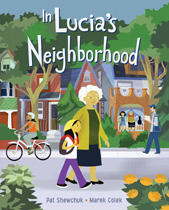Theme: The Neighbourhood Where I Live
Age Group: Pre-k… Preschool
Objectives: Students will be able to describe their neighbourhoods and they will be able to identify things that are common for all neighbourhoods.
Materials: The book, slides, printed sets of pictures, board and magnets.

Anticipatory Set: To draw the students’ attention, I will introduce the topic and will tell them that we are going to read a book about neighbourhoods. I will ask them to listen carefully as I will ask some questions at the end.
Body of the Lesson (Activity):
First, the teacher introduces the topic and reads the book. While reading, the teacher switches the slides with illustrations from the book. Then, the teacher asks some questions on the book to start a discussion on the topic. After that, the teacher takes a set of pictures and asks students questions about things that can be found in their neighbourhoods. When children name some objects (houses, trees, cars and so on), the teacher puts the corresponding picture on the board. Of course, the pictures include all objects and people mentioned in the book read. When this task is completed, the teacher divides the students in several groups (2-4 students) and asks students to describe their neighbourhoods to each other using the pictures. The teacher helps students and supervises their work in groups. After that, students are asked to create their common neighbourhood (things that can be found in all of their neighbourhoods). Finally, students can mime different things individually or in pairs (trees, drivers, cyclists and so on).
Direct Instruction & Guided Practice: After reading the book the teacher will ask the following questions:
Did you like the story? What is it about? What did you like most? Is your neighbourhood the same?
As for the group work mentioned above, the teacher will provide the following instructions:
You will now describe your neighbourhoods to your classmates. Use pictures just like we used them on the board.
It is necessary to note that in this activity older students will start to give younger students encouragement.
Closure / Assessment: At the end of the work, most active students will get ‘gold stars’, which will be added to the points earned during the class. The students will also name objects and people that can be found in the neighbourhood (one by one). If the student cannot come up with the object, he/she drops out.
Classification: It is possible to divide students of the class into active and passive. Active students are always eager to answer questions and they always start an activity (describing neighbourhoods). Passive students are quite shy and they often feel reluctant to talk. There are only a few passive students in the class.
NJ Preschool Teaching code: 6.1.B.1
Independent Practice: The game that can reinforce the learning outcomes can be as follows. At the end of the lesson, the teacher will ask the students to try to pay attention to all details in their neighbourhood on their way back home. During next several days, they will come to the class and create their neighbourhood using the sets of pictures available. When they are done, they ask a teacher to come and take a picture of their neighbourhood. Each students will be able to make several neighbourhoods and pick the best one (the most complete) at the end. In a week or two, the teacher will print out the neighbourhoods of children and they will make a poster.